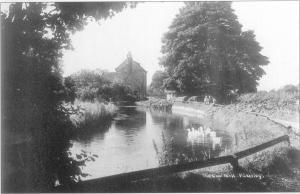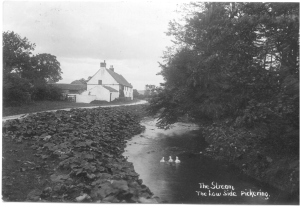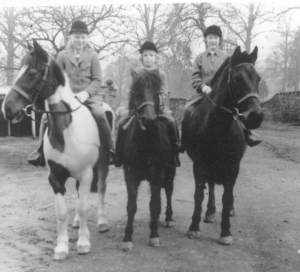Gay Girl, the piebald pony who pulled a cart.
The swarthy looking gypsy man grabbed the pony’s bridle and started to drag her along. Sitting in the saddle I was mute with terror. Mum had always told me that gypsies put a curse on you if you didn’t buy their wooden dolly pegs and here I was being dragged into the gypsy encampment.
A few miles down Haygate Lane the gypsies often camped near Ings Bridge, parking their caravans close to the beck with its abundant water supply and plenty of grass for their many ponies. A large campfire was always burning and bossy, barking dogs were everywhere. Hens and geese wandered around clucking and squawking and cats eyed me from a distance. The women were usually sitting round the campfire cooking the meals and carving small branches into wooden clothes pegs, dolly pegs, which they used to sell in town.
My new pony Gay had “turned her hog out” and refused to go along the lane through the busy, bustling camp. When the man took hold of the bridle I had visions of him tossing me in the beck and stealing Gay who would have merged well into their herd of piebald and skewbald coloured ponies.
Of course the man was kindness itself and made sure we were safe and sound. He gave me a couple of tips to make sure I was the boss, not the recalcitrant pony.
Gay Girl was the first pony that I actually owned. I was eight or nine. She was 13.2 hands high and an unfashionable piebald colour, with plenty of feathers on her heels betraying her workmanlike origins. 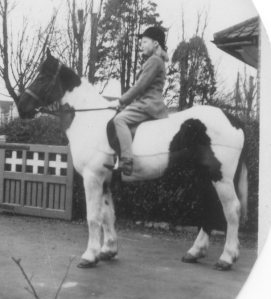 She had been used by Dick Wood to pull his flat cart. Dick was what my Dad called a ‘long-whipped-un’ and I remember he always held his head on one side and had a continual smile on his face.
She had been used by Dick Wood to pull his flat cart. Dick was what my Dad called a ‘long-whipped-un’ and I remember he always held his head on one side and had a continual smile on his face.
Dick wasn’t a gypsy although he lived in a small gypsy caravan in his yard located where the back of Eastgate joined Malton Road, but every itinerant who passed through Pickering stayed in Dick Wood’s yard which they shared with a myriad of mongrel dogs, hens, bantams, cockerels and spitting cats who ruled the street as well as the yard
He made a living by delivering goods on his flat cart. When Mum bought the grand-father clock, made by Malton clockmaker Robert Skelton, at a sale on Roxby Terrace in Thornton-le-Dale she put the brass clock face and works in her small Fiat car but it was Dick who transported the long-case wooden body of the clock back home to Pickering. We’re not sure if Gay was the pony he used then, but we strongly suspect she was.
My Dad knew Gay was good in traffic but no one knew if she’d been broken to saddle. A quick trip to Joe Thompson’s proved that she had, so Gay became my very first pony.
At this time we leased stables from the Forest and Vale Hotel, former home of the Kitching family. There was a high stone wall round the vegetable gardens down Malton Road and for some reason Gay didn’t like to go past the end and then down into Mill Lane. She “turned her hog out” and refused to go. Horace Milner decided to fix the problem.
Horace was a wonderful source of equine knowledge and a great encourager of young riders. He was groom for the Ellerby family so he was used to horses in general and fractious ponies in particular. One day he was clipping one of the big hunters which was getting quite twitchy… it suddenly dropped down dead and Horace realised the clippers were ‘live’; luckily he’d not touched any of the metal parts or he also would have been electrocuted.
“Hang on really tight” Horace instructed “and trot down Malton Road as if you’re going down Mill Lane.”
As we approached the end of the high wall I felt Gay start to slow down, her ears came back and the stride lessened. Just as we reached the corner Horace jumped out bellowing loudly and brandishing a large broom and he chased us down Mill Lane. I’m not sure who was the most scared, Gay or me, but I managed to stay on board and never again did she baulk at the end of that wall.
The Pickering to Malton railway line crossed Mill Lane at the gatehouse. The last passenger train to leave Pickering station was on 31 January 1953 but the line remained open for some goods traffic and special excursions for another few years, the final closure being 8 March 1965. One day the gates were closed as a train was due and I wasn’t sure how the pony would respond to the steam locomotive as it chuffed out of town. Gay rested her nose on the top of the white gates and was totally unconcerned by the snuffling, snorting monster steaming past.
Mill Lane was one of my favourite rides as it followed Pickering Beck. After the rail crossing you went over the bridge at the Vivers Mill millpond then on through the water splash at the mill itself, built in the 17th century.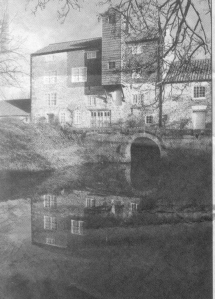 If the mill was working, the water splash was too deep and fast so you stuck to the road and continued over the disused Pickering-to-Helmsley railway line to join the Goslipgate Road.
If the mill was working, the water splash was too deep and fast so you stuck to the road and continued over the disused Pickering-to-Helmsley railway line to join the Goslipgate Road.
From here you rode down Lendales Lane to another 17th century mill known as Lendales or Low Mill. Over the years the mill race wall was built higher than the adjacent lane. I was always worried that the wall would break and I’d be swept away in the resulting flood. I never ventured down here after really heavy rain and the whole area flooded during wet times.
On past Low Mill was Leas Farm, home of George Leydecker a Polish pilot who had stayed in Britain after the war. Here the beck was easy to enter, a place where you could enjoy a paddle in the clear, shallow water. Nearby it opened into the sheep wash where, in earlier times, sheep had dirt washed from their fleece prior to shearing. From there you rode on to Ings Bridge, a mediaeval pack horse bridge where we re-crossed Pickering Beck. Here, just over Ings Bridge, was where I had my gypsy encounter!
Another of my favourite rides started off down Mill Lane but ended going up the old Pickering to Helmsley railway line, past the former Goslip Bridge junction which was closed in 1924. The track had been closed in the early 1950s and the rails and sleepers removed so it was a lovely cinder track, excellent underfoot for an exhilarating gallop. It was not quite eight furlongs long down to the gate house at Westgate Carr where there were some slip rails into a field, great for some jumping practice. There was often a white nanny goat tethered down here and she loved Polo mints… [Polo, the mint with the hole as the TV ads would remind us]. I always made sure I had a packet of Polo’s in my pocket as both Gay and the goat loved them, the goat gently butting me when she was ready for another one. We often shared a packet between the three of us.
The old railway line was also very pretty, the best catkins grew down here. These pussy willows had bright yellow male catkins and were used as the ‘palms’ to decorate churches on Palm Sunday. Later in spring and summer there were pink dog roses, yellow flag irises, white hemlock, hedge parsley and the poisonous berried cuckoo pint. Gay and I often spent time dreaming away and watching the birds and tortoise shell and peacock butterflies and collecting the beautiful wildflowers to take home and blackberries to make into delicious bramble pie.
We sometimes went to Thornton-le-Dale, back to The Hall stables and went out with Jane Thompson, daughter of Joe, and Mary Owen, daughter of Dr Owen. Here they are pictured on Patience and Popcorn respectively.
Jane was never as keen on horses as me and I used to envy her having so many to ride.
My beloved old pony nearly died one day after the vet had drenched her. I’m not sure if she reacted badly to the drench or if in error a small amount of the medicine went down into her lungs not into her stomach. I stayed with her for hours with a heavy heart, but luckily she recovered… the vet would not have been very popular with me if she’d died.
We did have our moments of hatred though. One day I had a very painful ‘boil’ in my ear, very red and inflamed and just about ready to burst. Gay was startled by something outside the stable and swung her head round, catching the side of my head. In excruciating pain I was felled to the straw but at least the boil then burst and relieved that swelling and former agony.
During the time at the Forest and Vale I used to ride with Josie Bradbury. She was from the West Riding of Yorkshire and was the niece of Peter and Annette Room who owned the hotel. Peter got on well with my father as he was also a former war time pilot and had the distinction of landing on an aircraft carrier and popping off over the front. The Rooms were a fun couple and I liked them.
Josie had a chestnut pony called Honey and we used to go off for a days trek with a packed lunch. We both enjoyed the Norman Thelwell cartoons of “Penelope” and her round, plump, bushy-maned pony and we both looked the part so it was good we were able to support each other among the elegant and immaculate show ponies and riders at the local Thornton-le-Dale, Rosedale and Ryedale Shows. I missed her school holiday visits when the Rooms left Pickering.
Initially we had leased stables at the Forest and Vale Hotel but those stables were knocked down to make way for the hotel car park and we moved down to the back stables in the walled garden before eventually moving to ‘The Ranch’ when my parents bought Mickle Hills and built the stables there and it was here that my French pen-pal Marie-Noelle Husson had her first ride on a pony.
A friend from school, Liz Austin, liked riding too. She was a bit older than me; her mum Kath worked in Miss Blench’s shop selling haberdashery and they lived in a terraced cottage looking down Smiddey Hill. Liz used to love doing hair, I often thought she should become a hairdresser, and she would style mine into all sorts of weird and wonderful shapes and she would plait Gay’s mane whenever she could. One barmy summer day Liz came down to The Ranch to ride Gay. It was sunny and warm and we were wearing shorts and tee shirts so we decided on a quick bareback ride, both on board together. It was great fun cantering round and we even ventured over some logs in the orchard. It wasn’t too long before Gay decided she’d had enough of these annoying girls and, as we cantered round again, with exquisite placement and timing, she executed a buck small enough to be almost imperceptible but large enough to unbalance the pair. We were not given the choice of t’muck or t’nettles, we were deposited in what must have been the largest patch of stinging nettles in Yorkshire.
My grandfather was a saddler and he decided I needed a new bridle. Mum took him to the Malton saddlery shop where he’d done his own apprenticeship all those years ago. Grandpa snorted with disgust at the scores of ready- made bridles, leather of London yellow, hanging on display. “Bring me some bridle leather to look at please” The apprentice brought out some shoulder leather. Grandpa scowled. “No bring me some real leather, a butt, not this rubbish.” With renewed respect for the old man, a few hides of quality leather appeared, dark Warwick in colour. Grandpa selected the best butt and gave his instructions. A flat, loose ring snaffle bit was his choice. A few days later he returned to collect his order and was obviously satisfied. I have no doubt he would have refused to collect anything other than top quality workmanship.
Hunting had always been a huge part of my life. Before I’d started school and before I started riding, we had usually been followers of hounds in the car. Aunty Jess was often with us. I have memories of climbing a hillside behind the Hartoft pub and seeing the fox break away below me. Another time Kim Barker was visiting from the West Riding and went out in the car with Mum. Hounds were close to the fox which climbed a tree onto the roof of a small cottage and then he popped down the chimney and no doubt made a huge mess inside the living room.
Once I had my own pony I could ride to hounds and Mum and Jess often followed in the car. Hounds met on Saturdays and I went most weekends during the season… it was a rare day when the Saltersgate Farmers Hunt or the Derwent Hunt were too far away for me to hack to the Meet. Sometimes I rode to Snainton on the Friday and stayed at The Coachman Inn, opposite the Derwent kennels. Charlie and Renee Nevatt ran the pub and their daughter Kay was about my age and also rode to hounds. We used to hack to the Meet with the Huntsmen Frank Turner and his hounds, and sometimes George Deighton. They were always long days but great fun.
I joined the Sinnington Hunt Pony Club and the first camp was at the Dymock family’s Beckhouse Farm at the bottom of Cropton Bank. They didn’t have enough horse accommodation so Gay stayed in the village in Mr Ford’s field… he was Horace Rushworth Ford and looked so like my grandfather, he had to be a relative!
When Pony Club camps moved to Duncombe Park in Helmsley there were plenty of stables but Gay always developed a dry cough there, more so than home, so we had to dampen her hay, oats and bran.
One year I remember visiting the King’s Troop camp and watching a rehearsal of their performance. Their musical ride was very spectacular especially when they charged towards each other at full gallop whilst pulling the heavy gun carriages. They must have been in camp whilst performing at the Great Yorkshire Show. At that time all our PC instructors were British Army, Brigadiers, Colonels and Majors, so arrangements would have been quite easy.
One instructor was Polish. Dr Bronowski always used to tell us “Make much of your horse” and we were allowed a regulation two pats on the neck.
Brigadier Wilson was one of the instructors who lived in Middleton, next door to my godmother Jessie Harrison at Stonegarth. In summer Isobel Heap and I spent many Saturday mornings being given expert riding instruction. Stella Wilson was a little younger than me and was a bit frightened of the ponies. She would burst into tears every so often and ask “Lift me off Daddy, please lift me off.” Stella’s love was ballet and she was much happier in her ballet shoes rather than her riding boots.
All the work meant Gay had to be shod frequently. My blacksmith Wilf McNeil was one of the ‘old school’, making the shoes to fit the hoof by ‘hot shoeing’ and adjusting the shape of the shoes when thy were red hot. He had shop up the Whitby Road, just past the old Police Station shown in the photo. The road was very narrow and there was no way of getting out of the way of passing lorries and cars. I didn’t like having to ride up here.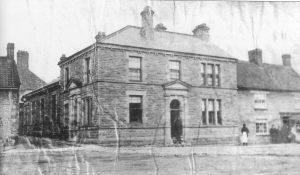
Wilf’s shop was very dark. There was a window near where you tied the horses, but it was so sooty that the only light to enter the place was through the open door and a red glow from the forge, I often wondered how he saw to shoe the front feet. The place was full of metal in all shapes and sizes, ploughs waiting to be repaired, new handles to add to this, new chains to be added to a harrow, a gate to be made for that, all sorts of archaeological masterpieces waiting to be re-discovered if they ever finally saw the light of day again, even through a sooty haze.
My ponies were shod every 6 weeks or so; sometimes they could have ‘removes’ if the shoe is not worn, otherwise a full set of new shoes was fitted. The old shoes were removed then the hooves were pared to trim off the growth. The hoof clippings had a characteristic smell beloved by dogs and sometimes I’d meet a dog owner waiting to collect the bits to hold in their hands to encourage their show dogs to race along with head high.
The shoe was made from a straight piece of metal; I often wondered how Mr McNeil knew exactly how much metal to cut as I don’t recall him ever using a ruler or tape to measure either the hoof or the steel. The metal was held by tongs in the forge which would suddenly surge into glowing orange life as the bellows added blasts of air. Soon the embryonic shoe was red hot and with a few hammer blows on the anvil they matured into shape. Holes had to be punched for the nails and clips placed correctly for the specific hoof and the stud hole had to have the screw thread put in. The shoe was heated up and held onto the hoof…. I remember disappearing into a cloud of fairly pungent smoke! It didn’t hurt the horse but it did burn the shoe outline onto the hoof so Mr McNeil could fine-tune his shaping. The shoe was not to be hit by the hammer too many times, so he had to know just what he was doing.
The nails used to fasten on the shoe had a special shape to make the point come out as a ‘clench’, and not penetrate the inner, sensitive part of the hoof, and Mr McNeil used to hold them all in his mouth as he worked round each hoof… I was always worried he would swallow one if a horse pulled away from him and was mightily impressed by his ability to swear at an uncooperative pony even with a mouth full of nails.
The Police station and Mr McNeil’s house and shop were demolished in the early 1960s to widen the road and improve access the RAF Fylingdales early warning station. A new Police Station was built where Eastgate Backside joined the Malton Road.
When his old shop was demolished Mr McNeil moved to a new concrete block place on Eastgate Back… it was new, light, shiny, tidy, boring and characterless after the mysteries of the dark hole on the Whitby Road.
I loved this epitaph to a blacksmith spotted on a local tombstone
Anvil and hammer lie declined, my bellows too have lost their wind,
My fires extinguished, my furse decayed, and in the dust my vice is laid,
My coals are spent, my irons gone, last nail I’ve drove, my work is done.
By the time Wilf had moved from his Whitby Road dungeon to the bright new concrete block modernity, I’d outgrown Gay and had moved onto a larger pony. In September 1959 Gay went to the West Riding to give another young girl her first fun on horseback.
Our Pony Club diary for every year had a verse from an Ogilvie poem at the end of each week. I used to love them. Here is the full poem relating to gypsies, very appropriate when I think of Gay.
Gipsies Horses by William Henry Ogilvie
Many a time I’ve wondered where the gipsies horses go
When the caravans have faded from the lanes;
When all the world of Romany lies buried in the snow,
And not a rose of any fire remains.
Are there fairy-builded stables in the brown New Forest fern?
Are there elfin stalls in Epping where they stand?
Are they haltered in the heather by some haunted Highland burn,
Where the blue hares change to witches out of hand?
Are they feeding down the sunset in some opal land of dreams,
Where the meadows stretch by rivers running gold?
Is it there that we shall find them, all the piebalds and the creams.
All the collar-galled, the weary and the old?
Whatever roof may shelter them, whatever fields they tread,
God grant them rest forgetful of the chains,
Till once again through England all the roses blossom red
Of the Gipsy fires alight along the lanes!
http://allpoetry.com/poem/8488037-Gipsies_Horses_-by-William_Henry_Ogilvie
